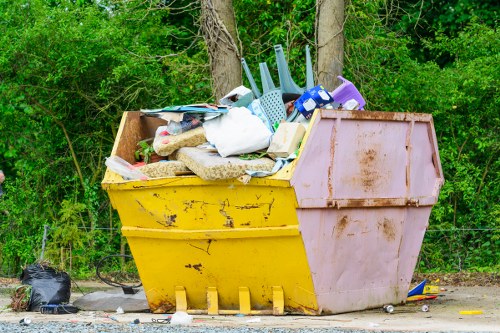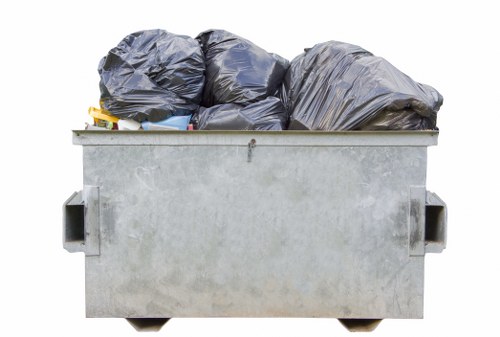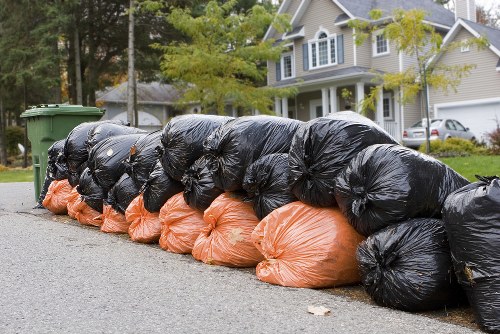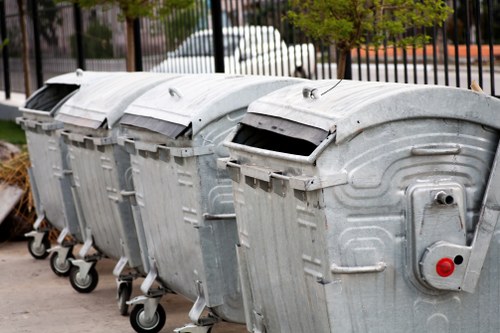Rubbish Removal Woodlands

Maintaining clean and healthy woodlands is essential for both the environment and the community. Rubbish removal in woodlands ensures that these natural habitats remain pristine, supporting biodiversity and providing a safe space for recreation.
Improper disposal of waste can have severe consequences on woodland ecosystems. From pollution of soil and water sources to harming wildlife, the impact of rubbish in these areas cannot be underestimated.
Engaging professional rubbish removal services in woodlands not only helps in preserving the beauty of these areas but also promotes sustainable practices that benefit everyone.

Importance of Rubbish Removal in Woodlands
Rubbish removal in woodlands plays a crucial role in environmental conservation. By systematically removing waste, we can prevent the degradation of these natural spaces and ensure they remain vibrant for future generations.
Clean woodlands contribute to better air quality, as trees and plants absorb carbon dioxide and release oxygen. Removing rubbish helps these plants thrive, enhancing their ability to purify the air.
Furthermore, maintaining cleanliness in woodlands encourages more people to visit and appreciate these areas, fostering a sense of community and responsibility towards nature.

Common Types of Rubbish Found in Woodlands
Woodlands often suffer from various types of rubbish, including:
- Plastic waste such as bottles, bags, and packaging materials
- Glass containers that can be hazardous to wildlife
- Food scraps attracting pests and disrupting local fauna
- Biodegradable waste that can still impact the ecosystem if not managed properly
- Construction debris from nearby areas affecting the natural landscape
Identifying and categorizing these types of waste is the first step in effective rubbish removal, ensuring that each type is handled appropriately.

Methods of Rubbish Removal
There are several methods employed in rubbish removal from woodlands:
- Manual Collection: Volunteers and workers physically collect rubbish, ensuring thorough cleaning.
- Mechanical Removal: Use of machinery to remove large amounts of waste efficiently.
- Recycling and Disposal: Sorting waste for recycling or proper disposal to minimize environmental impact.
- Community Engagement: Educating the public on responsible waste disposal to prevent littering.
Each method has its benefits and is often used in combination to achieve the best results.

Benefits of Professional Rubbish Removal Services
Hiring professional rubbish removal services for woodlands offers numerous advantages:
- Efficiency: Professionals have the tools and expertise to remove waste quickly and effectively.
- Safety: Proper handling of hazardous materials ensures the safety of both workers and the environment.
- Compliance: Professionals are knowledgeable about local regulations and ensure all removal processes are compliant.
- Sustainability: They focus on recycling and proper disposal, reducing the environmental footprint.
- Peace of Mind: Knowing that the woodlands are being cared for by experts provides reassurance to the community.
These benefits highlight the importance of investing in professional services for maintaining woodland areas.
Local Relevance: Nearby Areas to Woodlands
Woodlands are often surrounded by various communities and natural areas that contribute to their upkeep and use. Here are some of the closest areas to Woodlands that are significant for rubbish removal:
- Carolina Woods: Located just 5 miles from Woodlands, known for its diverse flora.
- Maple Grove Park A popular spot 7 miles away, frequently visited by families.
- Pine Hill Reserve: 9 miles distant, home to several hiking trails.
- Riverbend Forest: Situated 12 miles from Woodlands, featuring a scenic river.
- Greenfield Meadows: 14 miles away, recognized for its open grassy areas.
- Oak Ridge: 3 miles from Woodlands, known for its dense oak trees.
- Silver Lake Woods: 6 miles away, near a beautiful lake.
- Birchwood Trail: 8 miles from Woodlands, popular for biking.
- Cedar Grove: 10 miles distant, offering serene walking paths.
- Elm Street Forest: 11 miles away, famous for its elm trees.
Each of these areas plays a vital role in the overall health and sustainability of the woodlands. Effective rubbish removal in these regions ensures that the natural beauty and ecological balance are maintained.
Community involvement in these nearby areas can significantly enhance the efforts of professional rubbish removal services, leading to cleaner and safer woodlands for everyone.
By addressing rubbish issues collectively, these areas contribute to a greener and more sustainable environment, benefiting both nature and the people who enjoy these woodlands.
Challenges in Rubbish Removal
Rubbish removal in woodlands presents several challenges:
- Accessibility: Some woodland areas are difficult to reach, making the removal process more complex.
- Volume of Waste: Large amounts of rubbish require significant resources to manage.
- Hazardous Materials: Dealing with potentially dangerous waste requires specialized handling.
- Environmental Impact: Ensuring that removal methods do not harm the ecosystem.
- Funding: Securing enough financial resources to support comprehensive rubbish removal efforts.
Addressing these challenges requires strategic planning, community support, and professional expertise to ensure effective rubbish removal in woodlands.
Strategies for Effective Rubbish Removal
To overcome the challenges of rubbish removal in woodlands, several strategies can be employed:
- Regular Clean-Up Drives: Organizing periodic events to collect waste ensures ongoing maintenance.
- Community Education: Informing the public about the importance of keeping woodlands clean reduces littering.
- Partnerships: Collaborating with local organizations and businesses can provide additional resources and support.
- Use of Technology: Implementing tracking systems to monitor rubbish accumulation and optimize removal schedules.
- Recycling Programs: Encouraging the recycling of collected waste minimizes environmental impact.
These strategies, when effectively executed, can significantly enhance the efficiency and impact of rubbish removal efforts in woodlands.
Environmental Benefits of Clean Woodlands
Maintaining clean woodlands offers numerous environmental benefits:
- Enhanced Biodiversity: Clean habitats support a wider range of plant and animal species.
- Improved Air Quality: Healthy forests contribute to the reduction of air pollutants.
- Soil Preservation: Removing waste prevents soil contamination and erosion.
- Water Protection: Clean woodlands ensure that water sources remain free from pollutants.
- Climate Regulation: Forests play a significant role in carbon sequestration, helping to mitigate climate change.
These benefits highlight the critical role that rubbish removal plays in preserving and enhancing natural woodland environments.
Community Involvement
Community involvement is essential for successful rubbish removal in woodlands. When local residents actively participate, the efforts become more sustainable and effective.
Volunteering for clean-up events, spreading awareness, and advocating for environmental policies are ways the community can contribute. Additionally, fostering a sense of ownership and responsibility towards local woodlands encourages ongoing cooperation and support.
Engaging schools, businesses, and local organizations can amplify the impact of rubbish removal initiatives, creating a unified approach to maintaining clean and healthy woodlands.
Future of Rubbish Removal in Woodlands
The future of rubbish removal in woodlands looks promising with advancements in technology and increasing environmental awareness.
Innovative solutions such as drone-assisted monitoring, biodegradable waste alternatives, and automated removal systems are set to revolutionize how waste is managed in natural areas.
Furthermore, as more people become conscious of their environmental footprint, the demand for sustainable rubbish removal services will continue to grow, ensuring that woodlands remain preserved for generations to come.
Conclusion
Rubbish removal in woodlands is a vital practice that safeguards our natural environments. By understanding its importance, addressing the challenges, and implementing effective strategies, we can ensure that woodlands remain beautiful and thriving.
Community involvement and professional services play a significant role in maintaining cleanliness, promoting sustainability, and enhancing the overall health of these essential ecosystems.
Investing in rubbish removal not only benefits the environment but also enriches the lives of those who enjoy and depend on woodlands for recreation, relaxation, and natural resources.
FAQs
1. Why is rubbish removal important in woodlands?
Rubbish removal is crucial in woodlands to protect the environment, preserve biodiversity, prevent pollution, and maintain the natural beauty of these areas for both wildlife and human enjoyment.
2. How often should rubbish removal be conducted in woodlands?
The frequency of rubbish removal depends on the level of foot traffic and the specific conditions of the woodland. Regular clean-up drives, such as monthly or quarterly events, are generally recommended to maintain cleanliness.
3. What types of rubbish are commonly found in woodlands?
Common types of rubbish in woodlands include plastic waste, glass containers, food scraps, biodegradable waste, and construction debris. Each type requires appropriate handling to minimize environmental impact.
4. Can local communities participate in rubbish removal efforts?
Yes, local communities play a vital role in rubbish removal efforts. Volunteering in clean-up events, educating others about responsible waste disposal, and supporting local initiatives are effective ways to contribute.
5. What are the environmental benefits of keeping woodlands clean?
Keeping woodlands clean enhances biodiversity, improves air and water quality, preserves soil integrity, and supports climate regulation through effective carbon sequestration, among other environmental benefits.